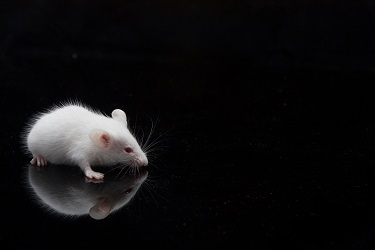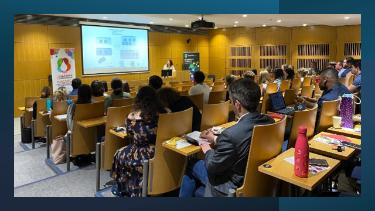Celebrating SBI's Women in Science
The following blog was written by Simeng Li and Isabel Quiros, PhD student and research assistant, respectively, working in Prof. Günther Eissner’s group in System Biology Ireland. As Women in Science, and in honour of the International Day of Women and Girls in Science (February 11th) and International Women's Day (March 8th), they have compiled the interviews below to celebrate some of the women working right in SBI.
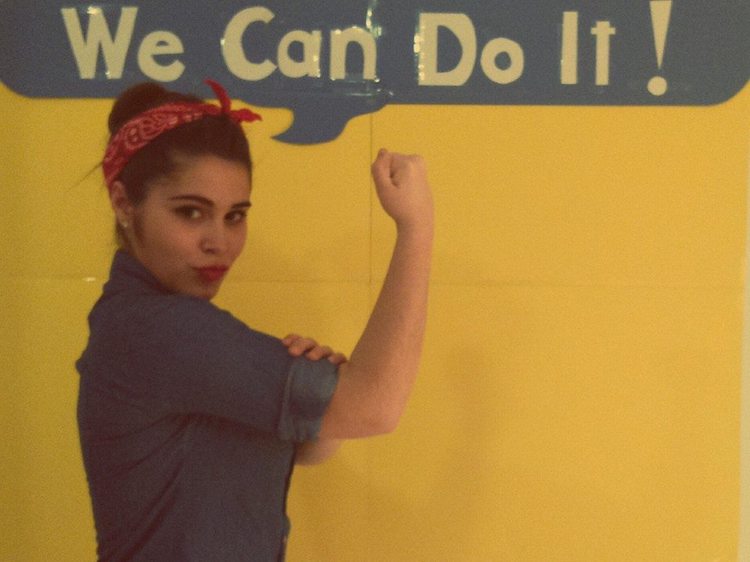
I remember perfectly in 2012, when I was cursing the second year of my undergraduate in Biochemistry, the European Commission released a video with the slogan “Science: it’s a girl thing” as part of a campaign to attract girls to careers in STEM (science, engineering, math and technology). At first, I was curious, but then I played the video and I couldn’t believe my eyes. Instead of feeling attracted to STEM careers, I felt quite the opposite -- I was horrified! Models wearing mini dresses, extremely high heels (worse, sandals in a lab), sunglasses and tons of makeup. There wasn’t a single lab coat or a pair of nitrile gloves, but there were lipsticks, make up brushes and jazzy eye shadow and blusher powders. This was so far from the the reality of working in a laboratory.
I definitely felt that this was not the way to make a career in science appealing to girls. That wasn’t the way that I wanted to be seen by the general public as a female scientist. I wanted to be perceived as the only man who appeared in the video, who, not surprisingly, was wearing a lab coat and looking through a microscope.
How fancy and appealing is an immunofluorescence image taken by a confocal microscope? It’s amazing! How fancy is it to observe your cells moving, dividing and multiplying? How fancy is it to know that you can modify the genome of your cells, knockout some genes and express some others as you please? How fancy is getting to know how your immune system works in order to protect us from microscopic enemies? How beautiful is it to know that you can help real people with real problems? These ideas are what moved me to become a scientist.
Fortunately, after all the critiques, the European Commission removed that campaign. Even if it was created with the best intentions, no model with fancy clothes should promote STEM careers. There are tons of super intelligent and hardworking women in science who should be the ones inspiring girls. We have many outstanding women researchers in SBI and we wanted to use this blog to get to know some of them.
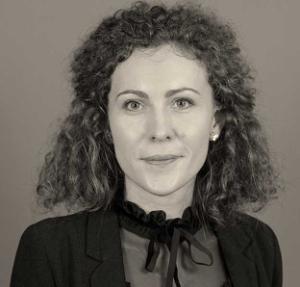
Interview 1: Melinda Halasz, Assistant Professor in Pathology at UCD School of Medicine and Group Leader at SBI, working in the field of Paediatric Oncology
How did you first become interested in science? Was it clear from a really young age or did it come while studying as a medical doctor?
As far as I remember, I always wanted to become a researcher. When I was a child, I spent my pocket money on books to read about nature, geography, animals, and biology. I was around the age of 6 when I found my mom’s high school biology book. This was my favourite book; it had a chapter on cell biology with fascinating drawings, and I tried to understand the composition of a human cell. The Hungarian word which means “cell” is a homonym, its other meaning is “to suspect”. In primary school, the teacher asked us to use the word “cell” in a sentence, and instead of using it as a verb “to suspect”, I quoted what I read in the biology book: “the cell is the smallest structural and functional unit of living organisms”. My teacher was impressed. So, since the age of 6, I wanted to study cells, cancer cells in particular.
Today (15th Feburary at the time of this interview) is International Childhood Cancer Day. What moved you to focus on malignancies in children?
When I was a medical student, I participated in the palliative care of patients suffering from end-stage cancer as a part-time nurse at a Hospice clinic. One of the patients was a teenager, and it was disheartening to see her battle with cancer. Unfortunately, childhood malignancies are characterized by the highest numbers of potential years of life lost to disease. Many childhood cancers can be cured today but it comes at a high cost; survivors suffer from long term toxicities and may develop secondary cancers. Therefore, with my group, we focus on finding less toxic and more effective treatments for neuroblastoma, which is one of the deadliest childhood cancers.
What else inspires you outside of work?
I love nature and the great outdoors; I love challenges, pushing beyond my own limits. For example, during university, I joined the local skydiving club and jumped out of a plane 21 times. I also completed ice climbing and mountaineering courses so that I can further explore my own limits. I have climbed several peaks in the Alps, the Mexican volcanoes, Elbrus in the Caucasus, and I also climbed in the Xinjiang region of China up to 6100 m. These adventures made me stronger, taught me to better trust myself, be headstrong and be determined in my career.
Did you ever feel the gender differences in the research/academic environment? Do you believe that the situation has improved in the last years?
I have been lucky enough to pursue my dreams, thanks to my parents, who made it possible for me to choose my own path and study medicine. I have always worked hard, I have had great female and male mentors, and ultimately, I have secured a tenured academic position. Unfortunately, there are many smart and talented young adults who do not have an opportunity to study at a third level institution (e.g., due to their socioeconomic status), and I see this educational inequality as a bigger issue than gender bias.

Interview 2: Stephanie McKenna, PhD student working in Gomez/Fey groups in cancer research. She is the best example that sparkly shoes and science don’t need to be incompatible. You can be fancy in a lab, but also, be safe (stilettos are not your best allies while working in a laboratory).
What inspired you to study science as a career? How old were you when you thought for the first time: I want to be a scientist?
I don’t remember ever choosing to have a career in science, but I’ve known since I was a teenager that I am a scientist -- whether I wanted to be or not!! A past supervisor very aptly described me as ‘following my heart and falling into’ the role. I chose to study what interested me and this is where I’ve ended up. I was one of those really annoying kids who always asked ‘why?’. I’m lucky that my parents fostered my curiosity and encouraged me to ‘figure it out’ rather than just telling me the answer…I come from a long line of nerds!
What is it that you are most proud of in your career?
I’m proud of being a first-generation university student and of course I’m proud of the PhD I’m still working on… but, like lots of other (especially female) PhD students, I have intense feelings of imposter syndrome. The thing that makes me most proud is communicating my science to different types of people in a way that they understand. Whether it’s working with a transition year student, my Instagram page or my mom, I love to see people ‘get it’. I think that’s the reason we scientists exist – to explain things!
What is your long term research goal?
As a final year student in her last 6 months, it’s hard to see past the dreaded thesis! After my PhD I hope to work in science/medical communications so that I can stay in touch with lots of different types of science.
Aside of working in Systems Biology Ireland, you are also co-founder of Solèy Haiti, a charity working with poor communities in Haiti. How did you decide to start this project?
I started volunteering in Haiti when I was doing my undergraduate degree. Myself and my co-founders took over the running of two Summer camps for children that come from the poorest districts. We work with local teachers and camp counsellors to provide a 4-week project. We also carry out construction projects for the development of the town. Our local partners have identified those most in need in the community and through working with our Haitian skilled construction team we have produced 3 homes to date.
It was a very easy decision for all the founders to develop this charity. We have seen the need first-hand, having travelled to the community on several occasions. We’re learning as we go and are very lucky to work with the local community.
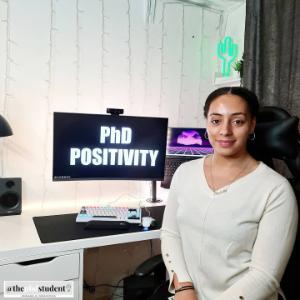
Interview 3: Annabelle Nwaokorie, PhD student working in cancer research with group leader Dirk Fey.
When did you start imaging yourself as a scientist?
I started imagining myself as a scientist in 3rd year of secondary school, 2012. I was 1 of 2 students in my school to be selected to participate in UCD’s physics week. During the week I was introduced to the field of Medical Physics, I was fascinated and knew from that moment I wanted to study Medical Physics in university. I believe it was from the week in UCD that solidified the idea of being a scientist and inspired me to pursue a 4-year honours degree in Physics with Medical physics and Bioengineering followed by a master’s degree in Medical Physics and a PhD in Systems Biology and Bioinformatics.
Did you feel passionate about computers first and discovered later that you could unite science and computers or was it the other way around: first wanting to be a scientist and discovered you were more on the dry lab side?
I definitely wanted to be a scientist first, later I discovered an interest in computers and the dry lab side of science. Throughout the last few years I have become more fascinated by computers, tech and coding. I think COVID-19 has really allowed me to invest time into the above. I have completed a number of online courses for coding and currently in the process of building my own PC, something I wouldn’t have done if it wasn’t for the pandemic!
You have an Instagram account with over 11.1K followers. How did you decide to describe your PhD pathway on social media?
I always aspired to do a PhD. I decided to make an Instagram page to document my journey from the beginning to (hopefully) the end. I have shared my experiences in academia and my PhD journey to date, by doing so motivating other students to do the same. I decided to document my PhD pathway as I want to shed a positive light on doing a PhD nowadays. I want to raise awareness on certain topics along the way such as mental health and wellness in PhD students.
According to a report by Informatics Europe (I. Europe, Informatics Europe report on informatics education in Europe, 2018. Accessed: 07/01/2020), in many European countries, including Ireland, 80% or more of the students enrolling or graduating in Informatics Bachelor programs were male (data from 2012-2017). At PhD level, most of the countries evaluated showed less than 25% of women graduating from Informatics PhD programs.
When you started narrating your PhD life on Instagram, was it a goal to inspire young girls to join computational science careers?
Of course! One of the main aims of my PhD Instagram is to motivate and inspire those in academia, and those who aspire to be in academia, particularly women and girls. I want to portray the positives and the everyday realities PhD students face, especially computational students. I want to show people that anything is possible, and you can do anything you put your mind to.
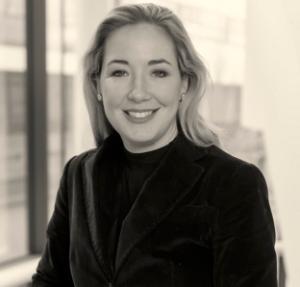
Interview 4: Eadaoin Mc Kiernan, Centre Manager at SBI. She has a background in biological Sciences, having completed a PhD in Biotechnology in Dublin City University and two postdoctoral trainings in cancer research in St. Vincent’s Hospital and University College Dublin. Currently in SBI she is responsible for operations management, strategy planning and execution.
When did you first become interested in science?
I was always curious about how things worked so the science subjects appealed to me in secondary school, particularly biology. Our class was lucky in that we had two great teachers who took an interest in our choices with respect to future careers, one a career guidance teacher and the other our class head. They both encouraged me to go down the science path when filling out my CAO forms.
How did you decide to move out of the lab?
During my first postdoc in St Vincent's Hospital I worked on an EU FP6 funded project. My supervisor allowed me to get involved in dealing with the other European partners and managing parts of the project. I really enjoyed this work. I found it more satisfying than the bench work so I took out a loan to do a Project Management Diploma in the evening. I also expressed an interest in project management to my supervisor who was supportive and tried to give me as much management experience as possible in the lab. When a position came up in RCSI to manage an MSCA postdoctoral fellowship programme I applied for it and was successful.
What advice would you give to young scientists who want to work in science but off the bench?
Get involved in different activities that are happening in and around the lab. There's always opportunities to learn about other career paths if you look for them. Talk to people, ask questions and don't be afraid to express where your interests lie...you never know who is listening and who might help you out.
Despite the progress, so many women still bear heavier load than men in balancing work and family. As a mum of a toddler, how did you find the balance between parenting and your job?
It´s been difficult to strike a balance at times. That whole period was a huge learning curve for me. Before having Rhys my life revolved around work. I loved my job and really liked the people I worked with. Then Rhys came along, stole our hearts and pretty much everything else in our lives (for both me and my partner) had to take a back seat. I had to work on achieving some form of work/life balance. I think I have a handle on things now but there's still the odd bump in the road. It helps if you're surrounded by people who are supportive, which thankfully I am.
Was working from home during this pandemic challenging regarding to work and family life balance? Did it help you to disconnect and have time for yourself during lockdown?
I've found it easier to strike a balance during lockdown. I live outside Dublin so I spent a lot of time commuting before lockdown... sometimes up to 4 or 5 hours a day. I had very little family time mid-week whereas now I can get most of my work done during working hours and then enjoy time with my family.
When I need to disconnect I go outdoors – go for a run or do some gardening. My partner and I recognise the need for downtime. We try to manage our time so that we both get a little personal time, even if it’s only 30 minutes for a run. It's really important for both of us.
